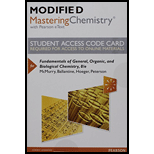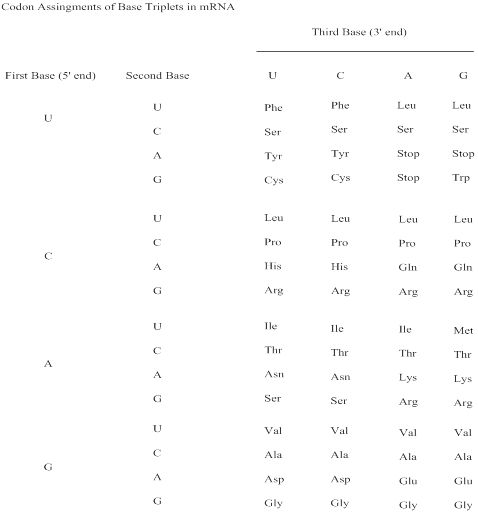
Concept explainers
Interpretation:
The three different base triplets that could be combined to code for the given amino acids Leu-Leu-Leu has to be predicted.
Concept Introduction:
Codon: A sequence of three ribonucleotides in the mRNA chain that codes for a specific amino acid; also a three-
Genetic code: The sequence of nucleotides, coded in triplets (codons) in mRNA that determines the sequence of amino acids in protein synthesis.

Illustrated relationships are:
DNA informational strand: 5’ ATG CCA GTA GGC CAC TTG TCA 3’
DNA Template strand: 3’ TAC GGT CAT CCG GTG AAC AGT 5’
mRNA: 5’ AUG CCA GUA GGC CAC UUG UCA 3’
protein: Met Pro Val Gly His Leu Ser
Notice: 5’ end of the mRNA strand codes for the N-terminal amino acid, whereas the 3’ end of the mRNA strand codes for the C-terminal amino acid. Proteins are always written N-terminal to C-terminal, reading left to right.
Want to see the full answer?
Check out a sample textbook solution
Chapter 26 Solutions
Modified Mastering Chemistry With Pearson Etext -- Standalone Access Card -- For Fundamentals Of General, Organic, And Biological Chemistry (8th Edition)
- Given the following mRNA sequence: 5-AUCCCGUAUGCCCGGGAGCUAGCCCAGC-3 a) Label the first condon, the stop codon, the untranslated regions and predict the amino acid sequence of the polypeptidarrow_forwardWhat will be the overall anti-codon sequence in tRNA for this mRNA? 5’-GUAGCCUUAUCUAGCGAUCACCGUCCGUAUUACUAGUGGCCAGACUCUUUUCACCAUGUAUAGUUG-3’arrow_forwardA eukaryotic cell carrying out transcription and RNA processing is incubated with 32P-labeled ATP. Where will the radioactive isotope appear in mature mRNA if the ATP is labeled at the (a) α position, (b) β position, and (c) γ position?arrow_forward
- The following is the only intron sequence of a gene that will be excised during the maturation of the mRNA. But it is not spliced in some tissues, where alternative splicing pattern is seen. Will the amino acid of its protein product following this sequence change? Explain with an example. ATAAGCCAGACTCAGCAarrow_forwardConsider the following mRNA base sequence 5' CUG-CAC 3' (a) What dipeptide is coded for by this mRNA? (b) What dipeptide is formed if a mutation converts CUG to CUU? (c) What dipeptide is formed if a mutation converts CAC to CGC? (d) What dipeptide is formed if a mutation converts CUG to CUU and CAC to CGC?arrow_forwardThe following is the only intron sequence of a gene that will be excised during the maturation of the mRNA. But it is not spliced in some tissues, where alternative splicing pattern is seen. Will the amino acid of its protein product following this sequence change? Explain with an example. ATGATAGCCAGACTCGCAarrow_forward
- The primary protein structure is shown in Figure 9-3(a).Where in the mRNA (near the 5′or 3′end) would a mutation in R2 be encoded?arrow_forwardOne procedure of obtaining cDNA from mRNA is by using oligo(dT) primers. What are oligo(dT)s? Why does using them make sense based on the processing (or modification) of precursor mRNA to get mature mRNA?arrow_forwardA synthetic mRNA added to a cell-free protein-synthesizing system produces a peptide with the following amino acid sequence: Met-ProIle-Ser-Ala. What would be the effect on translation if the following component were omitted from the cell-free protein-synthesizing system? What, if any, type of protein would be produced? Explain your reasoning. Q. GTParrow_forward
- Assuming that each nucleotide is 0.34 nm long in mRNA, howmany triplet codes can simultaneously occupy space in a ribosomethat is 20 nm in diameter?arrow_forwardThe hypothetical mRNA sequence below contains the coding region for a short peptide. What consequence for this peptide does the substitution of the uracil at position 28 of the mRNA with guanine have? GGUUGAAUGGAACAACGCGUGCACCCUUAGAGGUAACCCUCC | G Group of answer choices No consequence, it is a silent mutation. It shortens the peptide by two amino acids. It destroys the start codon of the peptide coding region. It extends the peptide by two amino acid. It replaces one of the original amino acids of the protein with a different one.arrow_forwardWhat is the total size of the mature i.e. fully processed mRNA in nucleotides? How many amino acids would the encoded protein be? Assume that the N- terminal Met encoded by the AUG start codon, is NOT cleaved from the protein?arrow_forward
 Biology Today and Tomorrow without Physiology (Mi...BiologyISBN:9781305117396Author:Cecie Starr, Christine Evers, Lisa StarrPublisher:Cengage Learning
Biology Today and Tomorrow without Physiology (Mi...BiologyISBN:9781305117396Author:Cecie Starr, Christine Evers, Lisa StarrPublisher:Cengage Learning
